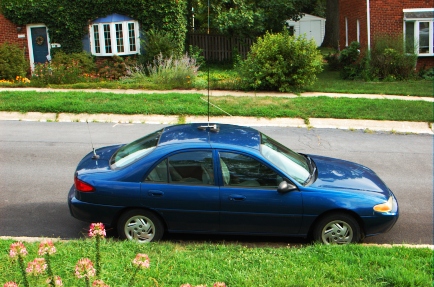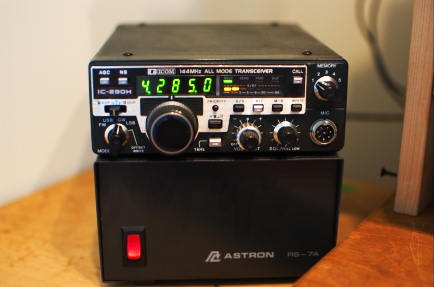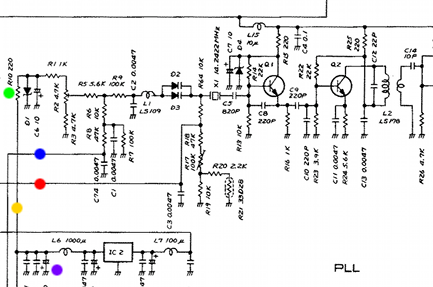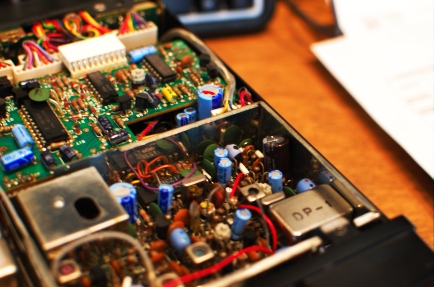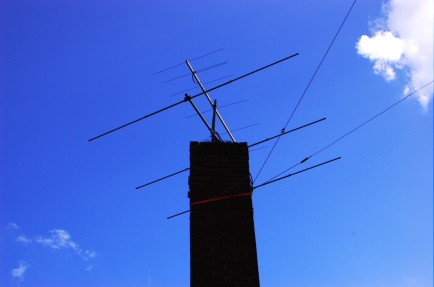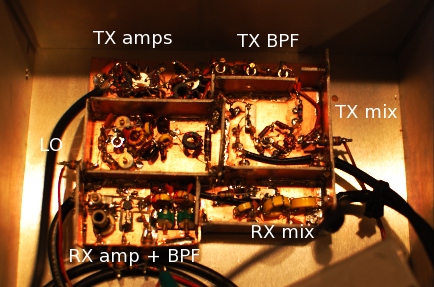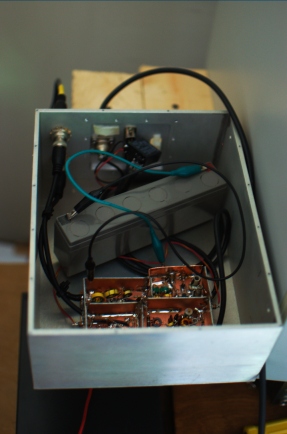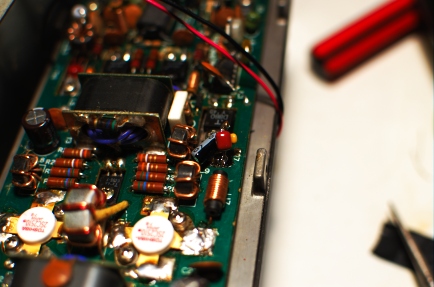Author Archive
 CW DX pranks
CW DX pranks
One of the perpetual frustrations of being in a rare (in ham radio terms) location (or just having a big signal from an exotic location) is handling the ensuing “pile-up” of stations calling you, separating them so you can hear them and keeping them from interfering with your signal. The sought-after (“DX”) operator must maintain control of the pile-up or pandemonium breaks loose. A tried and true technique for controling a pile-up is to spread callers out in frequency above the DX operator’s frequency, which should remain clear, except when the DX is transmitting, of course. This is called “working split” and on CW (Morse code mode), the DX operator indicates this condition by appending “UP” to his calls.
For unknown reasons, this concept is lost on some operators, who call repeatedly on the DX’s frequency much to the consternation of everyone else who is trying to make contact. Sometimes, it’s an honest mistake and after some “helpful” operators send “UP UP UP UP” a few times (also on the DX’s frequency), the offender catches on. But, in just about every pile-up these days, there’s always one or two operators at the shallow end of the pool of clue. Tonight’s JT5DX pile-up on 20 CW (listening from the mobile on the way home from work) was no exception.
I’m never sure whether to laugh or hang my head in shame when this happens…but, now and then one of the other operators in the pile-up will answer the poor clueless soul impersonating the DX and give him a contact! It shuts them right up and is usually good for a laugh. I do feel a little bad every time I hear it…but, if they don’t get it when the pile-up police send “UP UP” and the DX sends “UP”, how can you explain it to them?!
 K8GU/M (or how convert your 1999 Ford Escort into a real head-turner)
K8GU/M (or how convert your 1999 Ford Escort into a real head-turner)
When we got married, the Escort I was driving had gone to my parents in exchange for a larger vehicle with an automatic transmission and a 6-cylinder engine (all three points nods to Sarah, although I admit that it was a much better ride for the kind of driving we did). With the transfer of the Escort, my HF mobiling days were on hold, although I kept the gear.
In order to finance a DSLR a couple of years ago, I sold-off some ham gear I wasn’t using, notably the HF mobile equipment. I didn’t manage to sell the tri-magnet mount I borrowed from N8ET for the 2004 MnQP and a rather dismal attempt at WiQP. This mount had an interesting life, which included being destroyed at 75 mph on I-94 north of the Wisconsin Dells. I drop-shipped a replacement to N8ET, but had the good fortune of finding similar donut-shaped magnets and some heavy adhesive vinyl at Ax-Man Surplus. So, with a little epoxy and elbow grease, I fixed the mount while I was still in Minnesota. It lived to ride again in several QSO parties before my futile efforts to sell it. I raised the requisite capital for the DSLR before the mount sold. So, I kept it.
When we moved the DC area, it quickly became apparent that we were going to have to relinquish our delightful position as a one-car couple and the Escort returned to our lives, probably to the chagrin of my father and delight of my mother. Dad later passed along a Yaesu FT-5100 and mag-mount VHF/UHF mobile antenna which I promptly installed. But, I really longed for HF CW in the car like the good old days. So, a few weeks ago, I plunked-down $30 for some knock-off Hamstick-type HF antennas for 20 and 40 and put the Yaesu FT-840 back in the car. (Astute observers will note that I have a 100% Kenwood fixed station and a 100% Yaesu mobile station. The IC-290H and the DJ-580T are anomalies that I permit to persist in my life for various reasons.)
There is nothing like listening to JAs via long-path on the way to work…and getting funny looks from the other commuters at the same time. A car full of teenagers waved once. Friends and relatives have called it everything from “a space ship” to “a hunk of junk” (thanks, Rachel).
 IC-290H dial frequency offset
IC-290H dial frequency offset
Some time back, I had the good fortune to stumble across a broken IC-290H at an attractive price. The IC-290H is a synthesized mid-1980s 25-watt 2-meter all-mode transceiver. Since I had been contemplating a radio to use as the IF to my W1GHZ transverters for 903 through 3456 (yeah, still need to build/integrate all of these), I jumped. The problem was described as an offset of some tens of kHz between the dial frequency and the actual transmit and receive frequencies. Since the IC-290 lacks a user community like the TS-600 and TS-700 (my other 2-meter all-mode radio), I went to Google and then posted a quick inquiry on the Stanford VHF e-mail list to see if this was a common problem. Google produced nothing and the VHF list produced the usual “get the Service Manual” response. Since I already had the Service Manual thanks to the previous owner, I was set.
The synthesizer (“PLL”) in the IC-290H has at its heart a VCXO (shown above). The control voltage biases varactor diodes D2 and D3 in a tank circuit with crystal X1 operated between the series and parallel resonant frequencies (as a very high-Q inductor). Contributions to the control voltage come from the microprocessor (red dot), the receive incremental tuning (RIT, blue dot), and an overall bias of -9 V derived from 5 V using DC-DC converter IC2.
In the “PLL Adjustments” section of the Service Manual, the VCXO adjustments are outlined, checking the synthesizer output with a frequency counter. I noted that as I changed rotated the VFO encoder on the front of the radio and the digits changed on the display, the output frequency of the synthesizer changed accordingly. Similarly, the RIT caused the frequency to shift. Neither of these things were surprising since I could tune in different stations before. In USB mode at 145.998.5 MHz, the synthesizer should output at 134.250.0 MHz. I read it at 134.230.21 MHz, clearly the source of the almost 20-kHz offset. I nudged potentiometer R2 (against the vehement warnings of the Service Manual) and the output didn’t change. For good measure, I swept R2 over its entire extent with no change.
R2, it seems, controls amount of the available -9 V bias applied to the varactors. I checked the -9 volts line. Zero. Who stole the bias from the cookie jar? The 5 V line was sagging down to 4.23 V.
I removed IC2, which is in a metal can that resembles an overgrown Mini-Circuits mixer and has only “DP-1″ stamped on the cover in black ink. For kicks, I drove this little guy with 5 volts into no load and got well over -100 V out. Did this punk destroy other parts in my synthesizer? I put this question to Dad, who happened to be here over the weekend. He suggested that it might require a load to produce a regulated output. Good thinking. Nothing on the synthesizer board appeared to be charred. So, my theory was unlikely and I proceeded.
Without IC2, the 5 V line bounced up to 4.95 V. And, the output side (connected to L6) showed a DC short to ground. If you trace the circuit from the output of IC2 to one of the legs of R2, nothing should show a DC short. I looked for bridged solder traces. None. Taking the divide an conquer approach, I removed R10 (green dot), to isolate the entire RF portion of the circuit. Still shorted. So, this left the following three suspects: two 0.1 uF ceramic disk capacitors and a 10 V, 100 uF electrolytic. Since electrolytic capacitors, especially older ones, have a bad reputation for causing problems, I interrogated it first (C20, purple dot). Bingo.
The only 100 uF capactor I had on hand that even came close to fitting was a 50 V unit from a previous repair. I squeezed it in—it’s the big brown one against the edge of the case in the center of the photo below. Note IC2 “DP-1″ in the lower right corner.
So, I plugged the radio into a power supply and antenna. And, low and behold…it was about back on frequency. So, I completed the synthesizer and RIT adjustments in the Service Manual and put it back together. It actually receives WA1ZMS/B on 145.285.0, which, Doppler notwithstanding, is GPS-locked at 145.285.000… Stay tuned for the low-drive transverter IF modification in the next few months once I start building them again.
 50-MHz Progress
50-MHz Progress
As I mentioned in the previous post, I’ve made some strides toward getting on 6 meters over the weekend. I assembled the 3-element Yagi last weekend. It was leaning against a post in our back yard pointing skyward for a few days. I told Sarah that I was thinking of adding 18,431 more of these antennas so I could compete with the 50-MHz radar at Jicamarca. She was not amused. I hadn’t even mentioned anything about megawatts. Yes, Virginia, the mast in the photo is not square. The top portion of the mast is a little skewed in the rotor and it’s attached with rusty U-bolts that I’ve never loosened. I’m still turning the antenna with the TR-2, even though I have a T2X out here now. I will do that swap eventually. But, for right now, the TR-2 is doing fine.
In order to start moving the transverter toward its new home in a beautiful rack-mount enclosure that previously housed a 900-MHz digital repeater (not included when I obtained the box, unfortunately), I had to “re-arrange its internal organs”, as a menacing extraterrestrial used to say in Space Quest. Sarah wonders why I schlep all of this crap from place to place with us. I’ve had that rack-mount box longer than we’ve been married! It was just waiting for a chance to serve in my shack. Anyhow. You can see the layout above. Sarah says it looks like a doll house. Pretty sweet house, if I say so myself.
Here’s another view of the partially-integrated box. I’m running it off a battery because I don’t have the power supply subsystem installed in the box, yet. It’s really just a PA and some control circuitry away from operational. Although, I would like to align the TX side with a spectrum analyzer at some point.
I heard quite a few signals in the ARRL contest over the weekend. W5ZN comes to mind, as well as a couple of locals like N4QQ, who lives just a stone’s throw away on the other side of the Beltway (aka the wrong side of the tracks). I suspect that the locals would move the S-meter a little more (like past S9) if I put an IF amplifier in after the RX mixer. But, I’m not really keen to do that unless I have to.
Schematics will come once I’m finished. But, nothing about this so far has been rocket science (or brain surgery, as the rocket scientists say). I’ve just been following the Handbook.
 Magic: right place, right time
Magic: right place, right time
I put the 3-element 50-MHz Yagi (Cushcraft A50-3S) up yesterday morning with the 6-element 144-MHz Yagi (WA5VJB design) above it—just in time for the ARRL June VHF contest! The 50-MHz transverter is not yet complete, although I have the RX side done and the TX side makes about 250 mW. It’s not integrated and I haven’t started building the PA. Bummer because yesterday was a pretty good Es day from what N3OX told me last night.
With 10 watts from a TS-700S to a 6-element Yagi at 30 feet, there’s not a whole lot you can work on 144 MHz. Plus, everybody was on 50 MHz, so I could only hear the multi-operator and serious single-operator stations on 144 MHz locally. Around 21:00 local time, Sarah and I had just returned from a walk. I had pointed the beams WSW (my best shot from here is SW) and was slowly tuning up and down the band hoping for some tropo enhancement or something…and after a few passes, I heard on 144.210 MHz…
“CQ contest, CQ contest, looking for sporadic-E on two meters, CQ contest, Kilo Five Quebec Echo…”
That’s something alright! I figured the beam was in approximately the right place and gave him a call. He came right back and we exchanged grids. He was there for a few minutes and then disappeared as suddenly as he had appeared. I know he made at least one other QSO, but he was starting to fade by that point and I couldn’t hear the other side. Cool!
My logging software calculated the great circle distance as 1037 miles (1669 km) between FM19 (me) and EM31 (him). Either it was one heck of big meteor or (more likely) one heck of a sporadic-E opening. Either way, I’m pleased. Want more of that!
 Odds and Ends
Odds and Ends
Yesterday, I revisited this post listing on-going projects from December 2009. Some things have changed, some remain the same.
The computer stuff has all been crossed-off the list, except that the home server is off-line with a dead power supply (or motherboard). I’m somewhat loathe to spend any money on it, but I should be able to pick something up.
While it would probably have been cheaper to buy one of the HF/VHF/UHF combo radios, I’ve set off stupidly down the trail of building (and interfacing) transverters. I am just three amplifier stages away from having 3-5 watts on 50 MHz! …plus the interfacing. I’ve decided that interfacing transverters to radios is more difficult than actually designing and building the transverters themselves. I built the 903-MHz W1GHZ transverter during the Winter, but haven’t tried it on the air just yet. W8ISS announced recently that he had some leftovers from the group buy of W1GHZ transverter parts, including boards for 2304 and 3456 as well as some G6Y relay kits. I bought the lot. I have enough MMICs and chip caps in the shop to build these and since I’ll need to order a couple of mixers for the other transverters, I can hit the Mini-Circuits minimum order. Sometime. Microwaves may all get pushed off to Fall and Winter.
Through a strange coincidence, my wife and I independently decided that it would be a good idea to move my ham shack. The new location is closer to the center of activity in the house, which means I’ll operate more radio and be more accessible to her while I’m doing it. But, the feedline and rotator cable no longer reach my 144-MHz Yagi. Fortunately, I’ll be able to raid the K8GU coax stash shortly. In the mean time, I’ve been missing what appear from the Hepburn maps to be epic tropo conditions. Stuff happens.
QSLing, notably my favorite QSL topic—bureau cards. All bureau requests for KP4/K8GU have been processed. I ran out of CE/K8GU cards with 10 to go. I will run some more of these from a photo printer in the next couple of days. Piles of PJ2/K8GU, K8GU, and (go figure) AA8UP cards remain. I will get the PJ2 cards done this weekend since I have a box of cards on-hand. K8GU and AA8UP cards are awaiting a redesign.
Although it sounds like a lot, relatively little is getting done on any of these things thanks to an outdoor project at home. More on this in the future.
 TS-930S PA mod — first try
TS-930S PA mod — first try
As I wrote recently, I have been tackling the low-frequency instability problem in the TS-930S PA unit. My first attempt was to add several bypass capacitors to from the supply side of L7 to ground (through a lug on the Q7 mounting screw a short distance away). This should tame the drivers, although the problem is not there.
The hum came back when I pushed the power beyond about 50 watts. The push-pull MRF-422 final amplifier circuit in the TS-930 comes from Motorola EB27, with a few small modifications. However, it is not clear to my untrained eye where additional precautions could be taken. I have a hunch that my next target will be this portion followed by the 2SC2075 pre-driver stage if I come up empty on the finals.
